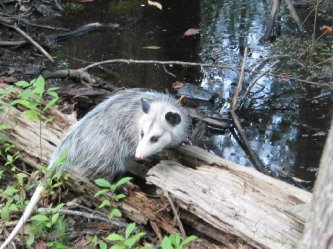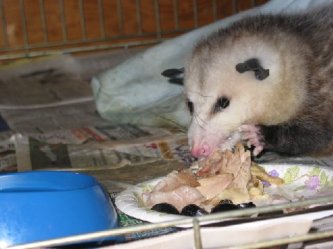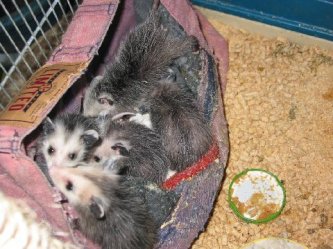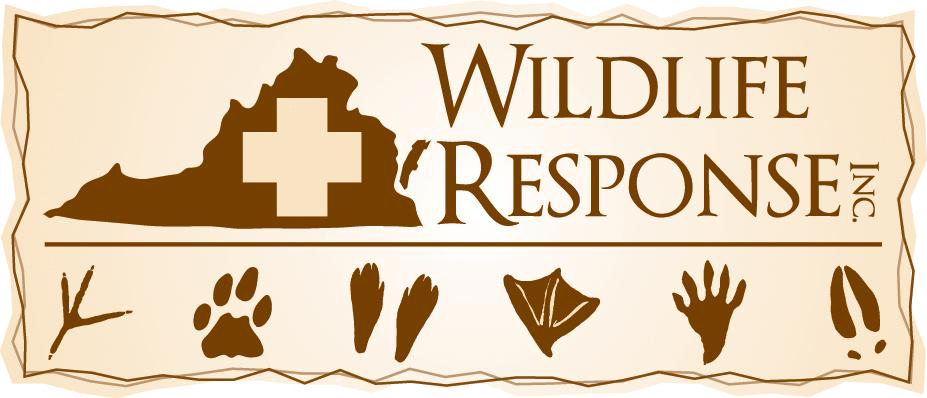(Didelphis Virginia)
 The Virginia Opossum is literally a living fossil. Its basic skeleton has remained unchanged for the last 90 million years. Its ancestors lived in the time of dinosaurs. The present day possum evolved into its present form around 75,000 years ago. The word opossum comes from the Algonquian Indian word “apasum”, which means “white mammal”. In 1612, Captain John Smith sent word to England that, “An opossum hat a head like a swine, and a tail like a rat and the Bignes of a cat”.
The Virginia Opossum is literally a living fossil. Its basic skeleton has remained unchanged for the last 90 million years. Its ancestors lived in the time of dinosaurs. The present day possum evolved into its present form around 75,000 years ago. The word opossum comes from the Algonquian Indian word “apasum”, which means “white mammal”. In 1612, Captain John Smith sent word to England that, “An opossum hat a head like a swine, and a tail like a rat and the Bignes of a cat”.
The opossum is a unique species among our North American mammals. It is the only marsupial. Females have a pouch or “marsuprin”. It is found in most of the lower 48 states, as well as the southern part of some Canadian provinces. It is a medium- sized animal. The average adult weighs between 12 and 13 pounds. They continue to grow throughout their short life. The fur color ranges from white to almost black, but usually appears gray. Long guard hairs give the fur a coarse appearance. The ears and tail have no hair. The possum’s tail is its most notable feature. It is a myth that they hang by their tail. They will wrap their prehensile tail around branches to brace themselves or steady their position. They will carry nesting material with their tail, curling it around the matter they wish to carry. They are able to grasp branches and food easily due to the unique structure of their feet. Four of their toes have sharp claws, but the fifth, the big toe, lacks a nail and is opposable, like the human thumb. This allows the opossum to have extreme dexterity.The opossum has a relatively small brain for its size but this has not inhibited its ability to adapt to a variety of environments and climates. They catch on quickly to a reliable food source. They have a well developed sense of smell, which aids in food location. The opossum is a true omnivore. They will eat virtually everything. Their diet encompasses an extraordinarily diverse range of items. They will eat fruit, bird’s eggs, mice, insects, slug, snails, earthworms, nuts, mushrooms, grain crops, snakes, garbage, lizards and carrion. Raids to chicken houses and gardens are rare. Young opossums do not have to be taught to find food. The sight of live, moving food excites them to capture, kill and eat. They are nocturnal, solitary scavengers that do not hibernate.
 For its size , the opossum is the shortest- lived mammal. Other mammals its size frequently live for 10 years or more. Opossums almost never live more than 2 years. Most fail to reach the age of two. The opossum does have natural enemies but the major cause of possum mortality is the automobile, which may be due in part to the possum’s attraction to road kill. The opossum is still hunted for its meat and fur. Owls, snakes, coyotes and dogs also take their toll.
For its size , the opossum is the shortest- lived mammal. Other mammals its size frequently live for 10 years or more. Opossums almost never live more than 2 years. Most fail to reach the age of two. The opossum does have natural enemies but the major cause of possum mortality is the automobile, which may be due in part to the possum’s attraction to road kill. The opossum is still hunted for its meat and fur. Owls, snakes, coyotes and dogs also take their toll.
The opossum is best known for “playing possum”. When a possum is threatened, it will first show it’s teeth and hiss similar to an angry cat. If that fails to scare off the predator, the possum may run away or climb a tree. As a last resort, the possum will “play possum”. It will curl up in a trancelike state, body limp, eyes open and sometimes tongue hanging out. It is not a conscious act of pretending but is a genetically programmed response. Even after the threat has passed, the possum may remain in this state for minutes up to hours.
The survival of the opossum may be due in part to their reproduction. The female will often raise two litters in a year. Each litter may contain a dozen babies. Mothers often succeed in raising half of them. Females are able to reproduce as early as age 6 months. The combination of early reproduction and large litters has insured the possums survival. As with all marsupials, possum young are born in the embryonic state. The newborns are about the size of a honey bee. An entire litter may fit in a tablespoon. After birth, they must crawl up into the mother’s pouch, where they will remain and nurse for about 2 months. This is an extremely important evolutionary development. The mother never has to return to a den to feed her young. She can continue her wandering lifestyle to find food and sleep where she likes.
 Between two and three months, the young possums will emerge from the pouch. For a few days, they will remain in a den while mother searches for food. After a few days they begin to wander with mother or ride on her back. As their fifty teeth develop, they will wean from their mothers , begin to eat the diverse diet of the possum and become the solitary scavenger they are meant to be.
Between two and three months, the young possums will emerge from the pouch. For a few days, they will remain in a den while mother searches for food. After a few days they begin to wander with mother or ride on her back. As their fifty teeth develop, they will wean from their mothers , begin to eat the diverse diet of the possum and become the solitary scavenger they are meant to be.

